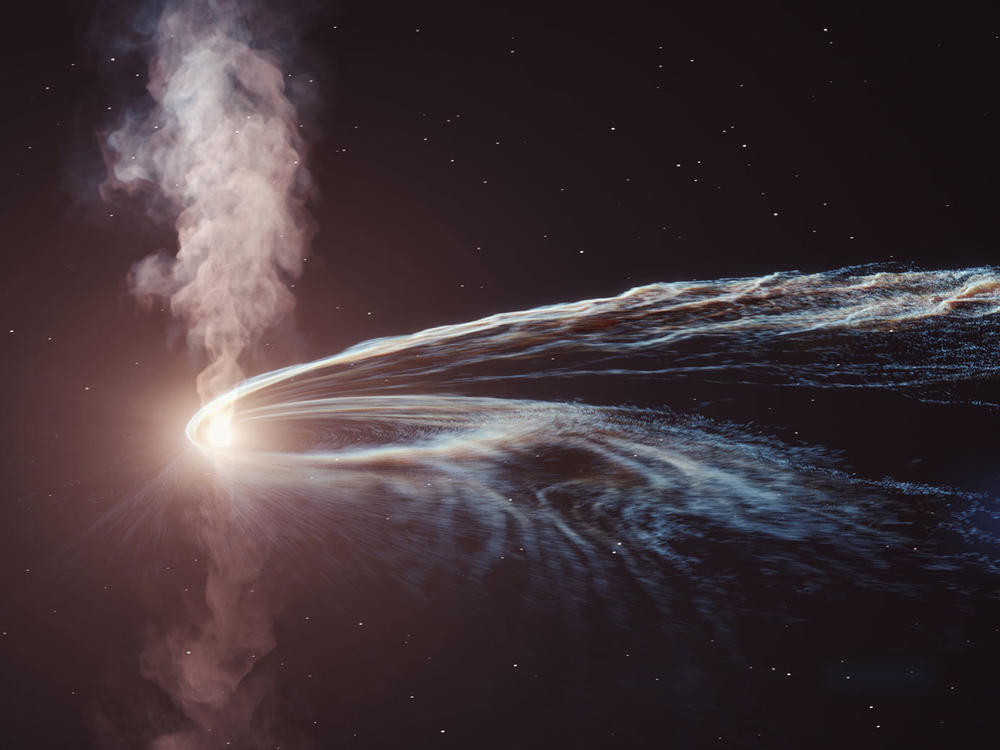Section Branding
Header Content
A black hole is releasing some strange burps, baffling scientists
Primary Content
Astronomers have published a major finding: A black hole has been "burping" out energy from a small star it was observed shredding in 2018, after two years in which it didn't eject any such material.
How unusual is this?
"Super unusual," Yvette Cendes, an astronomer at the Center for Astrophysics, Harvard and Smithsonian and lead author of the paper, tells NPR. "We've never really seen this before to this degree."
Researchers made the discovery when they used a powerful radio telescope facility — the Very Large Array in New Mexico – to check in on some two dozen black holes where stars had been shredded after coming too close to them. That is, the material in the star was pulled apart, or "spaghettified." Such happenings are called tidal disruption events, or TDEs.
What they found was that one of the TDEs (the one named AT2018hyz, if you're curious) was emitting energy at an unusual velocity and at a very surprising time: more than two years after the event.
This behavior is different from what has been observed in black holes before, in two ways. First, the timing: it's more common to see radio emissions from black holes within the first few months after swallowing a star. And second, the energy being emitted in this case doesn't quite fit with what astronomers have seen before.
In most cases of black holes swallowing stars, perhaps 99%, the outflow is lower in energy. And in 1% of cases, that outflow is way more – "an extremely jetted event," says Cendes, a very rare occurrence.
But in this case? It's in between – about half the speed of light.
This marks "the first case where we've seen this sort of speed associated with this event or this type of outflow," Cendes explains. "But also that it happened — the best estimate we have is about two years after the star got eaten by this black hole is when this outflow began — and that's really exciting. That's never been seen before."
And scientists aren't sure why it's happening.
Cendes says that while the research team has been good at ruling out what isn't causing it, they don't yet have an answer for what is.
Perhaps you're wondering: Hey, I thought nothing could escape from a black hole?
"There's a point when you get too close to a black hole that you can no longer escape the black hole – that's called the event horizon. But this material never crossed that boundary, according to our best estimates," Cendes explains.
In other words, the star got close enough to the black hole to get shredded – but not to fall into that point of no return.
The team's discovery means fascinating new avenues for research.
"For theorists, this is really exciting because suddenly it's really opening up a new dimension in our understanding of physics and what is possible. ... They definitely need to get to work and tell me what's going on because I'm also very curious," laughs Cendes.
And, she says, there are other star-swallowing black holes to study in greater depth. It could be that occurrences like this are more common than astronomers previously thought.
For Cendes, the discovery is what she and her fellow astronomers hope to find – something big.
"I wanted to be an astronomer since I was 13 years old," she says. "Making this discovery is really been the excitement of a lifetime for me. ... It was definitely a lot of work and I definitely had a lot of good collaborators helping me get this out, but it was very, very rewarding and it's what I wanted. So this has been pretty awesome."
Copyright 2022 NPR. To see more, visit https://www.npr.org.

